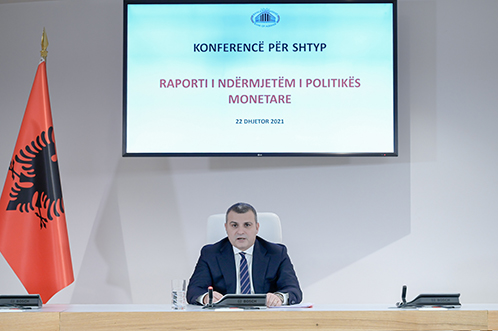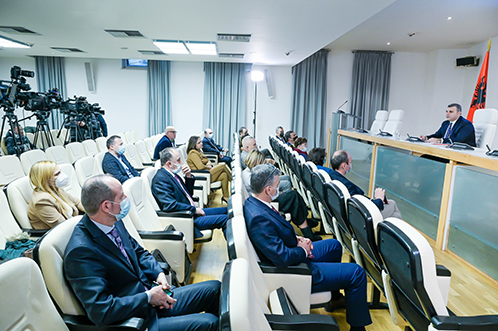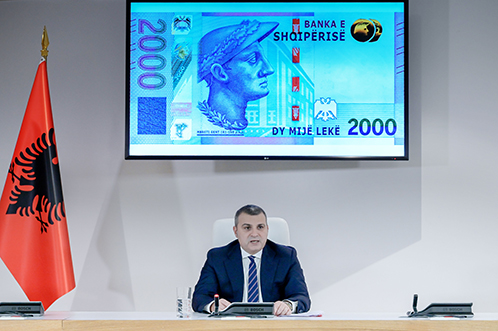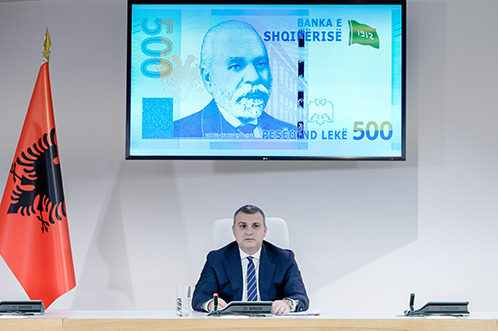BANK OF ALBANIA
PRESS RELEASE
Governor Sejko: Statement to the Press Conference on Monetary Policy Decision
Publication date: 22.12.2021
Dear Ladies and Gentlemen,
In today’s meeting, 22 December 2021, the Supervisory Council of the Bank of Albania reviewed and approved the Intermediate Monetary Policy Report.

The analysis of the available information shows the economic activity in Albania continues to recover, labour market indicators are improving, but inflation has risen sharply in the last two months. The upsurge in prices for oil, electricity and food in global market, have started to be reflected - both directly and indirectly - in the prices of consumption items in Albania. They have originated from the temporary misadjustment between demand and supply. In this view, their effect will be present also in the course of the first half of the coming year, but – further - it will subside.
In the baseline scenario, the convergence of the economy to equilibrium and the reduction of the effects stemming from the supply-side shocks will enable inflation to return to the target in the second half of 2022.
Against this backdrop, the Supervisory Council assesses that the current monetary policy stance remains adequate.
[Let me now make an overview of the findings of this Report in greater detail.]

The new information we analysed was overall in accordance with our expectations.
Inflation in Albania increased sharply, reaching at 3.1% in November. The rise in demand, employment and wages has pushed inflation up in the course of 2021. Nevertheless, the upswing in inflation, in the fourth quarter, primarily reflects the effect of the considerable rise in prices for food, oil and electricity in global markets. This shock is expected to keep inflation above our target in the next months. Further, we expect demand-supply to re-adjust in global markets, logistic problems be resolved and energy prices to stabilise. This performance will ease inflationary pressures and reduce the effect of foreign prices on inflation in Albania.
Economic activity grew at a fast pace over 2021, and growth sources were broadly based. The Gross Domestic Product expanded by 11.7% in the first half of year, bolstered by the increase in consumption and investments, both private and public ones, and by the growth in the exports of goods and services. Although available information is partial and indirect, it suggests the further growth of economy in the second half of year. Nevertheless, the economic growth rates are expected to be lower and fluctuate around the potential growth level, while the strong effect of comparative base with 2020 will be reducing.

The expansion of economic activity was accompanied by the improved labour market. Employment rose by 0.7%, unemployment rate dropped at 11.3% and the average wage recorded an annual increase of 6.9%., in the third quarter. Improving trend in labour market indicators and the increased job demand reported from enterprises signal that pressures on the growth of wages will strengthen in the future.
Increased confidence in economy, the improved external environment, and the domestic simulating economic policies have underpinned the economic growth. This broad gamma of factors suggests the sustainability of the economic growth in the future.
The accommodative monetary policy stance has: reduced the costs of financing; boosted credit growth; and contributed to the easing of the borrowers’ financial situation. Hence, it has supported the expansion of economic activity and has created the prerequisites for the return of inflation to target.

The interest rates on loans to both enterprises and households have remained at low levels, in reflection of the good liquidity situation, the contained risk premia and the supportive approach of banks to their clients. Also, the exchange rate has been characterised by two-sided fluctuations in the last two months.
Bank credit has recorded high growth rates, by increasingly supporting the rise in consumption and investments. The volume of credit to private sector recorded an annual growth of 11 % in November. Credit grew to both enterprises and households for investment purposes and for meeting short-term liquidity needs, both in lek and foreign currency. The augmented loan demand, as reported in the bank lending survey, the eased credit standards and the sound position of banking industry suggest a good performance of credit in the next period. In particular, the fall of non-performing loans ratio to 6.2% in November, shows the increase of both enterprises and households’ creditworthiness, as well as the improved soundness of banking sector balance sheets.
The fast increase in revenues and the mitigated growth pace of primary expenditures have driven to a slowdown of the fiscal stimulus in the last months. Nevertheless, the high accumulated level of expenses, coupled with the budget deficit, in December, implies a possible upsurge of fiscal stimulus to the economy.
The Bank of Albania judges that fiscal policy consolidation in the future is reasonable - given the strengthening of sustained recovery - also necessary to expand the space for facing potential shocks in the future and enhancing the macroeconomic stability of Albania.
***
Our projections for the outlook remain positive. The favourable financing conditions, the improved confidence and private sector's balance sheets, and the gradual normalisation of the economic activity in partner countries are expected to support the economic growth over the medium term. These factors are expected to boost the increase in consumption, investments, and exports. Expansion of economic activity will be accompanied by the more dynamic increase of employment, wages and other production costs, by strengthening the domestic inflationary pressures. Inflation, underpinned by these factors, is foreseen to sustainably return to 3% target at the end of 2022, and stay close to it in the medium term. On the other hand, the external supply-side shocks will dictate inflation rates above the target in the short run, but their effect is expected to be transitional.
The balance of risks surrounding inflation appears tilted upside in the short run and balanced in the medium term. In one hand, a faster or prolonged increase of prices in international markets and a slower consolidation pace constitute upside risks to inflation. On the other hand, slower recoveries of both global and Albanian economies, due to the prolongation of the pandemic or upswing of prices in international markets, constitute a downside risk to inflation.
***
Judging on these projections, the Supervisory Council of the Bank of Albania deemed that the current monetary policy stance remains adequate. The monetary stimulus supports the increase in the demand for goods and services, compensates the expected reduction of fiscal stimulus and establishes the premises for the rise of employment, wages and inflation in line with our target.
In this view, the Supervisory Council decided to:
- Keep the policy rate unchanged, at 0.5%;
- Keep the overnight deposit and overnight lending rates, unchanged at 0.1% and 0.9%, respectively.
At the same time, the Supervisory Council notes that the achievement of inflation target in the medium term will require the gradual normalisation of the monetary policy in the next period. This normalisation is expected to begin in the coming quarters. The reduction of monetary stimulus guarantees the observation of our inflation target and establishes the premises for a sustained economic growth in both medium term and long term.
However, the Supervisory Council notes that the balance of risks to inflation continues to remain to the upside, dictated by the prolongation and intensity of the supply-side shock in global markets. Against this backdrop, the Supervisory Council highlights that it will carefully monitor inflation performance and its determinant factors, to assure - in any case -that the monetary policy stance is consistent with the achievement of inflation target.
***
Dear media representatives,
In conclusion of this communication, taking the opportunity that this meeting is the last one for this year, I would like to present a brief overview of the work of the Bank of Albania in 2021.
The last couple of years were unprecedented and challenging to the Albanian economy and the Bank of Albania. I am pleased to note that the institution rose up to the challenges and successfully fulfilled its legal duties.
As I mentioned in the first part of my speech, the accommodative monetary policy implemented by the Bank of Albania has provided a significant contribution to the economic recovery, after the shock of the pandemic.
In addition, this policy is accompanied by an intensive decision taking of the Bank of Albania regarding supervision, licensing and regulation of banking activity. The focus in our supervisory activity was the revision of regulatory framework to minimise the consequences originating from the pandemic, in addition to the continuation of the work for the convergence of our activity regulations and practices with the best international standards. In the context of the pandemic situation, the Bank of Albania:
- Approved the suspension of the profit allocation for 2020 and of the profit to be realised in 2021 of the banking industry up to December 2021.
- Implemented some temporary regulatory amendments, which postponed the payments of instalments or eased the restructuring process of loans to those households and enterprises facing difficulties caused by the pandemic.
In parallel, the Bank of Albania has continued to implement its duties in the framework of licensing, supervision and regulation of the banking sector, throughout 2021. I would like to note here the further progress in the consolidation field of banking industry, with the proposed acquisition of Alfa Bank from OTP Bank, the continuation of the collaboration with homologue authorities in the framework of the supervisory colleges and the fight against money laundering, as well as the continuing work for the compilation and revision of the supervisory regulatory framework, aimed at its further approximation to the EU directives and regulations and with the Basel Committee standards.
Developments in the field of bank resolution have taken place in the last couple of years, by completing the regulatory and methodological resolution framework with other by laws and methodological documents, in compliance with the European regulatory framework, and by fully preparing the resolution plans for all banks of the banking sector.
In the field of Payment Systems, the Bank of Albania paid special attention to the fulfilment of strategic objective for boosting both financial inclusion of population and the use of electronic payment instruments. The legal and regulatory interventions coupled with the undertaken infrastructural developments in place since 2018 and so far, in the framework of the Albanian National Retail Payments Strategy (NRPS), have resulted successful, while their impact is expected to become more notable in the next years.
The Bank of Albania has continued to manage the foreign exchange reserve, in compliance with the main objectives of investing foreign currency reserve: liquidity and security. For this purpose, I would like to point out the finalisation, in 2021, of the new arrangement with the European Central Bank, represented by the Bank of France, on the approval of a credit collaterised line up to €400 million.
Notwithstanding the created difficulties due to the pandemic, the Bank of Albania has continued, throughout this period, to contribute and perform its duties in the framework of the European integration process of the country, in all its dimensions. In more concrete terms, the Bank of Albania has fulfilled at a considerable level the commitments arising from the National Plan for EU Integration, and has participated actively in all the meetings with the respective EU sub-committees.
Public communication has always been a constant priority of the Bank of Albania. For the purposes of ensuring that the duties and activities of the institution are adequately understood by the broad public, the Bank of Albania, throughout the conduction of its activity, has always been focused on the implementation of a responsible and transparent communication policy. For this reason, the National Bank of Austria in its report “Focus on the European Economic Integration” for the second quarter of 2021, which contains a detailed analysis on the transparency and communication with public, ranked the Bank of Albania first among all the banks of Central, Eastern and South-eastern countries.
Issue of the banknote, its physical security and the well-management of cash, is another crucial pillar in our activity. The Bank of Albania successfully addressed the emergency situation created by the pandemic. In June 2021, we signed the agreement with the ECB on the protection of euro banknote from counterfeiting, making thus the Bank of Albania an integral part of the European process in the fight against banknotes counterfeiting.
In addition, we have continued the work for the completion of the new series of banknotes. In June 2021, two other denominations, 1,000 Lekë and 10,000 Lekë were put in circulation. The particular in this process is the addition in the series and the production of the banknote with the highest denomination of 10,000 Lekë. At the same time, I would like to emphasise, that in 2021, there were produced the two last banknotes of the series, 500 Lekë and 2000 Lekë, which are expected to be put in circulation in the next days, by concluding the completion of our new series composed of six banknotes and six coins.
The new banknotes will be available to the public starting from 17.01.2022 by circulating in parallel with the other banknotes of the current series. These banknotes are designed and produced with state-of-the art technology and embody contemporary and sophisticated security features.
The vision, leadership and devotion of the Supervisory Council made possible the work, achievements and results in the activity of the Bank of Albania. The Supervisory Council has guaranteed the well-functioning of the institution and has oriented and leaded the compilation of the Medium -Term Development Strategy of the Bank of Albania.
The Internal Audit has assisted the Supervisory Council throughout its activity. This important function was certified pursuant to the International Standards for Internal Auditing, and fulfilled all the planned auditing engagements.
In conclusion, I would like to point out that the Bank of Albania will continue to carefully supervise both the economic and financial reality of Albania. Many challenges lay ahead, but what I note is that the institution is able to tackle them. Hoping that 2022 will drive to an end to the pandemic and enable the return of both social and economic life to normality, I reaffirm that the Bank of Albania remains fully committed for taking the adequate measures in fulfilling its legal mission.

 Twitter
Twitter
 Youtube
Youtube
 Facebook
Facebook
 Flickr
Flickr
 RSS
RSS
 Subscribe
Subscribe
 Feedback
Feedback